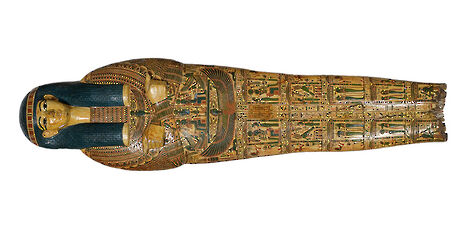State of the Art: Making Sense of Sarcophagi
Columnist Peter Chappell explores Nespawershefyt’s Coffin at the Fitzwilliam and the issue of appraising non-Western art

In my room, I have a small Turkish rug. It’s small because larger sizes were expensive; my Dad bought it for me in the Grand Bazaar in Istanbul in 2015. It swirls with abstract patterns like the silhouettes of human bodies. The black and red ellipses are like eyes, the jagged lines like little dancing limbs. The ochre thread weaves a dizzying haze of geometric detail.
I thought of those indistinct and unnatural figures when I saw Nespawershefyt’s (it’s nearly unpronounceable) sarcophagus in the Fitzwilliam this week. Egyptian art, so closely linked to ancient magic, ritual and an unknown religion, was long overlooked by the Western art establishment. However, the Fitz has nurtured its Egyptian artwork; it has the 15th largest collection of Egyptian artefacts in the world, with around 16,000 pieces.
“It was only relatively recently that anyone could guess what the beguiling and seemingly mysterious language of hieroglyphs might mean, let alone presume to locate Egyptian art within their ancient culture.”
It was only relatively recently that anyone could guess what the beguiling and seemingly mysterious language of hieroglyphs might mean, let alone presume to locate Egyptian art within their ancient culture. The huge expanses of time in which Egyptian art exists within make the mind boggle; the artists which painted this sarcophagus lived the same distance in time away from the pyramids being built as we do from the fall of Rome.
This sarcophagus wasn’t created for a pharaoh, but rather for a high-ranking civil servant in the Temple of Aman at Karnak. This is a burial coffin for the Alastair Campbells or the Steve Hiltons of 3000 years ago. His job was to keep records, and the administrative classes grew rich in Egypt’s developing economy. It is comprised of an outer and inner coffin, with a mask that would be positioned on top of the mummy. This is displayed vertically as you walk into the room in the Fitzwilliam.
Deities and men cover the coffin, illustrating scenes from the Book of the Dead in anticipation of what is to come. What fascinates me is that the sarcophagus is fully decorated inside and out. Not one surface is left untouched by the artists’ brush strokes. Even the part where the mummified body was placed gleams with a golden lustre from ancient pigments. The figures danced for thousands of years in the dark of the coffin.
Egyptian art seemed to have served an expressly religious purpose. There are two obvious manifestations of this. One is that the art shows the deceased an image of what is to come in the afterlife according to didactic theology. The other function seems to be that it would teach the dead the way to the afterlife, a kind of instruction manual on how to die. What was shown in the art could happen for a spirit in the afterlife.
For example, drawing bread would give the spirit of the deceased nourishment in the afterlife. This would certainly explain the numerous figures and tools put in with the body when it was buried. Like these tools, the pictorial representations of the wood of the sarcophagus are meant to be of personal utility to the deceased. You wonder what the relationship between the patron and the artists must have been; the painters were choosing the designs the patron would keep with him for eternity, on his journey to the afterlife.
Down partly to the legacy of artists like Pablo Picasso, who popularised the reevaluation of art from a non-Western tradition, Egyptian work is prized as much for its artistic merit as its historical worth
 Features / Should I stay or should I go? Cambridge students and alumni reflect on how their memories stay with them15 December 2025
Features / Should I stay or should I go? Cambridge students and alumni reflect on how their memories stay with them15 December 2025 News / Dons warn PM about Vet School closure16 December 2025
News / Dons warn PM about Vet School closure16 December 2025 News / Cambridge study finds students learn better with notes than AI13 December 2025
News / Cambridge study finds students learn better with notes than AI13 December 2025 News / News In Brief: Michaelmas marriages, monogamous mammals, and messaging manipulation15 December 2025
News / News In Brief: Michaelmas marriages, monogamous mammals, and messaging manipulation15 December 2025 Comment / The magic of an eight-week term15 December 2025
Comment / The magic of an eight-week term15 December 2025










